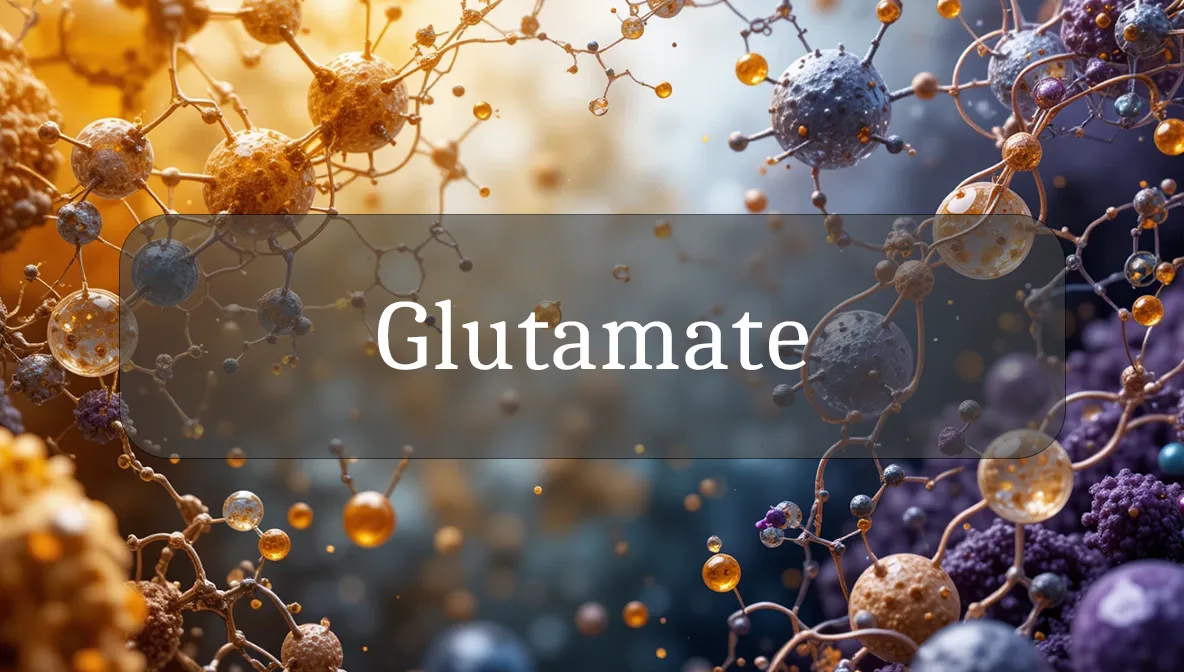Amino Acid for Brain Power and Energy
Glutamate might sound like a scientific term, but it’s a vital amino acid that acts like a spark in your body, powering brain function, boosting energy, and supporting muscle health. Found in foods like cheese, tomatoes, and meats, glutamate is a key player in daily wellness, especially for those seeking mental sharpness and vitality. Let’s dive into what glutamate is, why it matters, and how to support it for a healthier you, all in a friendly, easy-to-understand way.
Identity and Type
Glutamate, also known as L-glutamic acid, is a non-essential amino acid, meaning your body can produce it, but you can also get it from food. It’s a building block for proteins and the most abundant excitatory neurotransmitter in your brain, meaning it helps nerve cells “talk” to each other. Glutamate is found in cells and plays a role in energy metabolism and signaling. Think of it as a nutrient that keeps your brain buzzing and your body energized.
Biological Role and Health Benefits
Glutamate is like a master communicator, supporting key functions:
- Brain Function: As a neurotransmitter, glutamate drives learning, memory, and focus by activating nerve cells, promoting mental clarity and cognitive health.
- Energy Production: It fuels the citric acid cycle (Krebs cycle), producing ATP, your body’s energy currency, keeping you energized for daily activities.
- Muscle Health: Glutamate supports protein synthesis, aiding muscle repair and growth, especially after exercise, making it great for active lifestyles.
- Immune Support: It provides energy for immune cells, helping your body fight infections and stay resilient.
- Gut Health: Glutamate is a fuel source for intestinal cells, supporting a healthy gut lining and digestion.
By powering your brain, muscles, and gut, glutamate boosts overall vitality.
Dietary Sources and Supplements
Glutamate is abundant in protein-rich foods and available in some supplements:
- Dietary Sources:
- Meats and Seafood: Chicken, beef, pork, and fish (e.g., salmon, tuna; 3 oz chicken = ~2,000 mg glutamic acid).
- Dairy: Parmesan cheese, cheddar, and yogurt.
- Plant-Based: Tomatoes, mushrooms, soybeans, and corn.
- Other: Eggs, walnuts, and fermented foods (e.g., miso, soy sauce).
- Supplements:
- L-glutamic acid or L-glutamine (a precursor) supplements (500–5,000 mg per serving), often used for gut health or athletic recovery.
- Monosodium glutamate (MSG), a flavor enhancer, provides glutamate but is not a health supplement.
- Body Production: Your cells synthesize glutamate from other amino acids (e.g., glutamine) or metabolic intermediates (e.g., alpha-ketoglutarate), meeting most needs unless under stress.
- Environmental Sources: Glutamate is in the food chain through plants and animals, with diet as a primary source.
A balanced diet typically provides plenty of glutamate for most people.
Signs of Imbalance
Glutamate imbalances, usually excess or dysfunction, can affect brain and energy health, while deficiencies are rare:
- Low Glutamate:
- Symptoms: Fatigue, poor focus, or muscle weakness. May include slow recovery from exercise or low immunity.
- Causes: Severe protein malnutrition, chronic illness (e.g., liver disease), or rare genetic disorders affecting glutamate metabolism.
- Impact: Can impair brain signaling, energy production, or muscle repair, reducing vitality.
- Excess Glutamate:
- Symptoms: Headaches, irritability, or brain fog from overexcitation of nerve cells (excitotoxicity). Rarely, seizures in sensitive individuals.
- Causes: Overuse of glutamate supplements, high MSG intake in sensitive people, or neurological conditions (e.g., stroke, Alzheimer’s).
- Impact: May overstimulate brain cells, causing stress or damage in extreme cases.
If you notice brain fog, headaches, or fatigue, consult a doctor to assess glutamate or metabolic status.
Supporting Optimal Levels or Function
Maintaining healthy glutamate levels is easy with these tips:
- Eat Protein-Rich Foods: Include 3–4 oz lean meats (e.g., chicken, fish) or 1 cup mushrooms daily for ~1,500–2,500 mg glutamic acid. Add tomatoes or cheese for variety.
- Balance Protein Intake: Aim for 0.8–1.2 g protein per kg body weight daily (e.g., ~56–84 g for a 70 kg person) to support glutamate and other amino acids. Mix animal and plant sources.
- Support Brain Health: Eat magnesium-rich foods (spinach, almonds) and omega-3-rich foods (salmon, flaxseeds) to balance glutamate signaling and reduce excitotoxicity risk.
- Exercise Moderately: Engage in 30 minutes daily of exercise (e.g., walking, strength training) to boost glutamate’s role in muscle repair and energy production.
- Limit MSG if Sensitive: Reduce processed foods with MSG (e.g., some snacks, soups) if you experience headaches or sensitivity, though most people tolerate it well.
Blood tests for amino acid profiles or neurological markers can assess glutamate status if needed.
Safety, Interactions, and Precautions
Glutamate is safe in dietary amounts, but supplements and MSG require caution:
- Safety: Dietary glutamate from foods is safe for most. High-dose supplements (>5,000 mg daily) or excessive MSG may cause headaches or digestive upset in sensitive individuals.
- Interactions: Glutamate or glutamine supplements may interact with antiseizure medications or neurological drugs, potentially altering effects. Consult a doctor if on these.
- Precautions:
- People with neurological conditions (e.g., epilepsy, migraines) should avoid high-dose glutamate supplements to prevent overexcitation.
- Those with kidney or liver disease should consult a doctor before using supplements, as they may stress metabolism.
- Limit MSG-containing foods if you have a known sensitivity, though scientific evidence on “MSG syndrome” is mixed.
- Storage: Store protein-rich foods (e.g., meats, dairy) in the fridge or freezer. Keep glutamate or glutamine supplements in a cool, dry place, sealed tightly.
Fun Fact
Did you know glutamate is the secret to that savory “umami” taste? It’s naturally high in foods like Parmesan cheese and soy sauce, making your meals delicious while fueling your brain and muscles!
Citations
- National Institutes of Health (NIH). (2023). Amino Acids and Health.
- Mayo Clinic. (2024). Monosodium Glutamate (MSG): Is It Harmful?
- Cleveland Clinic. (2023). Neurotransmitters and Brain Health.
- World Health Organization (WHO). (2022). Protein and Amino Acid Requirements in Human Nutrition.
- USDA National Nutrient Database. (2023). Amino Acid Content in Foods.

